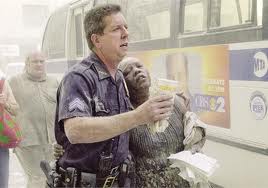Lately, I have been pondering altruism, one’s unselfish devotion to the well-being of others often without regard to personal well-being. I admit I am befuddled by the concept. It challenges theories of evolution and even caused Charles Darwin to question his own theory of natural selection—how could these acts of self-sacrifice exist in a world full of the fittest habitants, that possess only an incentive to survive and reproduce? Regardless, I find it very encouraging to witness such selfless behaviors from my fellow mankind. This behavior takes many forms in many aspects at many different times.
 For instance, I reflect on the aftermath of September 11, 2001. This date was one of the earliest times in my life when I acknowledged altruism’s existence. I remember people gathering in tribute to the dead, celebrities organizing benefit concerts to raise money, and yellow ribbons streaming across nearly every home and shirt lapel signifying compassion for lost lives. After Hurricane Katrina swept through the Gulf Coast, citizens all over the nation offered their support; my family even opened our home to refugees for a few weeks. Similarly, this year’s September flooding of the southern tier of New York and the recent damaging snow storms of the East Coast have brought out the kindness and generosity of neighbors. From the Flight 93 passengers to storm rescuers, altruism spurs many questions: Why are some people willing to help even at their own expense? Why do some feel the urge to help more strongly than others? Can altruism be learned or is it innate?
For instance, I reflect on the aftermath of September 11, 2001. This date was one of the earliest times in my life when I acknowledged altruism’s existence. I remember people gathering in tribute to the dead, celebrities organizing benefit concerts to raise money, and yellow ribbons streaming across nearly every home and shirt lapel signifying compassion for lost lives. After Hurricane Katrina swept through the Gulf Coast, citizens all over the nation offered their support; my family even opened our home to refugees for a few weeks. Similarly, this year’s September flooding of the southern tier of New York and the recent damaging snow storms of the East Coast have brought out the kindness and generosity of neighbors. From the Flight 93 passengers to storm rescuers, altruism spurs many questions: Why are some people willing to help even at their own expense? Why do some feel the urge to help more strongly than others? Can altruism be learned or is it innate?
I am certain these questions are studied frequently, and I am unsure if mankind will ever thoroughly understand this behavior. I did, however, recently read an article in the Wall Street Journal that suggests that altruism can be taught, and it seems to be present in children as young as 15 months, which implies altruism as a genetic component.
After reading this, I wondered about the effects of teaching children to care. Altruism could transform from a selective and unexpected behavior to be more habitual and second-nature. Common courtesy could become more common.  Paying it forward could become less known as a movie and more known as a humanistic characteristic.
Paying it forward could become less known as a movie and more known as a humanistic characteristic.
Because children model adults, our actions can foster selflessness in our children. So as a society, we cannot simply rely on an altruism gene; we should be a role model for others. I remind myself each day of the quote, “Be mindful of the eyes that are upon you, looking to you as an example of how to shape their lives.” I know I am always looking for inspiration from other people, and I recognize that others may do the same with me. What impression am I leaving for others to follow? Hopefully, from now on, it is a more altruistic message.
Though it may only be a dream, I can imagine the world with more harmony if altruism becomes a social norm. People would be more concerned with others than themselves, and the environment would flourish as it receives tender love and care from its selfless citizens. When disaster strikes, no one would hesitate to help or be reluctant to provide support. While Martin Luther King’s great dream is being fulfilled and Walt Disney World makes its visitor’s dreams come true, maybe my dream can become a reality too.
Pingback: Good As You Want To Be « Raxa Collective
Pingback: Wordsmithing: Altruistic « Raxa Collective
Pingback: The Buzz « Raxa Collective
Pingback: The Evolution Of Cooperation « Raxa Collective
Pingback: Victory Is Good, Goodness Is Great « Raxa Collective
Pingback: Big Business, Conservation, Innovation | Raxa Collective
Pingback: Know Paul Piff | Raxa Collective